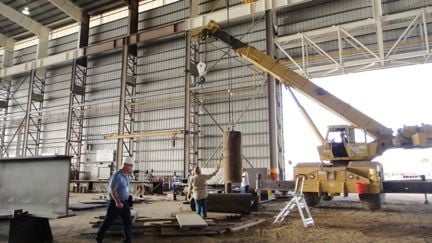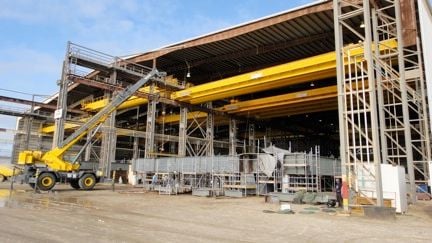4 Steps to Avoiding a Crane Collision
In a fabrication or assembly facility there can be a host of material handling that occurs during the general nature of work. The delivery of steel plate, beam, tubing and other raw materials or equipment is often performed in a variety in ways.
Typically a forklift or telehandler will move material from a storage yard or building into a fabrication bay. The material often needs to be sorted for initial fit-up and assembly. That’s when the cranes get involved. In bays with open ends, it may be inviting to integrate the use of a small mobile crane to assist the overhead bay cranes for material sorting and assembly.
When a boom type crane is tasked to work in a shop bay, the opportunity for accidental contact with obstructions is ever present. An even greater risk is at hand, with an overhead crane and mobile crane attempting to work in the same area. The overhead crane operator may not see the mobile crane boom due to fabrication obstructions. The mobile crane operator and assigned rigger/welder may not be looking up to ensure continued clearance with an approaching overhead crane. In both cases, the machines may be moving towards one another simultaneously with almost potentially disastrous results.
If one crane strikes another in this situation, the suspended load(s) can be easily dislodged and dropped, the load(s) can swing violently or there may be a crane derailment or tip-over. Nothing good can come out of this ticking time bomb.

If a mobile crane or other high reach machinery (aerial work platform, telehandler with mounted boom, high-mast forklifts, etc.) is working in a crane bay, the site management needs to ensure certain precautions are in place. The following are options that management can take to minimize the risk involving “dueling” cranes:
- De-energize the overhead crane closest to the mobile crane. Make sure that additional cranes in the bay respect the de-energized crane and do not strike or push the tagged out machine. Instruct all personnel about the temporary work restrictions.
- Place rail clamps onto the runway rails so that they provide hard stops, in order to limit the travel of the bridge crane nearest the mobile crane. These aren’t designed as bumper stops, but are only for accidental over-travel. Hang warning tape or install floor level barrier cones to help highlight the maximum allowable travel distance of the bridge crane nearest to the mobile crane. Instruct all personnel about the temporary work restrictions.

- A somewhat less desirable method of protection is to have an “umpire” stationed between the two machines. The first rule is that neither crane can move horizontally without the umpire’s approval. The second rule is that the cranes cannot move horizontally at the same time. His approval is only granted when he can ensure that the opposing crane is stationary, while the other crane is in motion. Caution should be expressed to the overhead crane operator to compensate for crane “coasting” after the travel controller moves to neutral. Instruct all personnel about the temporary work restrictions.
- All personnel should be aware that lifting and handling long loads like I-beam can potentially contact any obstruction, exposed electrical bus-bar, or particularly the nearest crane. Don’t assume that vertical handling isn’t a risk in a congested work area as described in this article. Instruct all personnel about the temporary work restrictions.
There are some in our industry who would strictly prohibit the use of high reaching machines in overhead crane bays, but that doesn’t seem very practical. The secret is to have a game plan in place that minimizes the risk and have employees follow the approved procedures while adhering to the imposed operational restrictions. The ideas proposed here don’t represent an exhaustive list. There may be a number of other approaches that can be taken to avoid an incident related to high reaching equipment in an assembly bay. The best approach generally includes a combination of mechanical or electrical restrictors, visible barricades and trained personnel who are actively respecting the existing operational conditions.
Happy trails,
P.S. For more information about crane operations refer to ASME B30.5 Mobile and Locomotive Cranes and ASME B30.2 Overhead and Gantry Cranes. Both ASME Volumes are available at the iti.com/bookstore or asme.org.
One last thing, when it comes to getting your operators more seat time, don't forget about the simulator option. ITI VR offers a safe, self-paced training environment for operators of all skill levels, on multiple types of load handling equipment. Build and price all the options today by clicking the link below!




COMMENTS